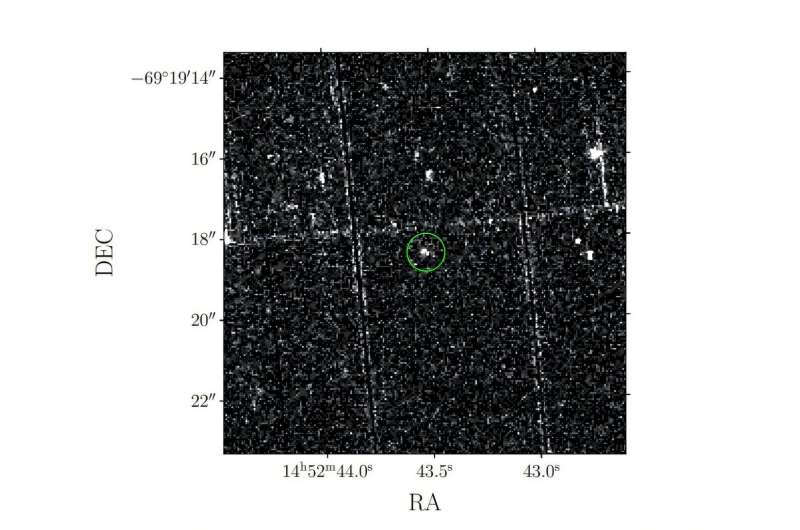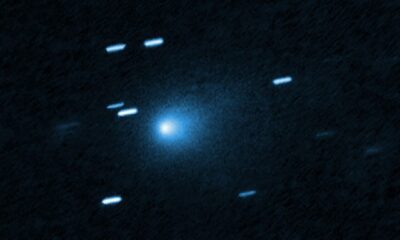Science
Astronomers Unveil New Long-Period Radio Transient ASKAP J1448−6856

An international team of astronomers has discovered a new long-period radio transient, designated as ASKAP J144834−685644, or ASKAP J1448−6856 for short. This finding, detailed in a paper published on July 17, 2025, enriches the limited catalogue of known sources in this emerging class of astronomical phenomena.
Long-period radio transients (LPTs) are characterized by their ultralong rotation periods, ranging from minutes to hours, and are associated with strong magnetic fields. Current theories suggest that they may originate from rotating neutron stars known as magnetars or from magnetic white dwarfs. Despite various observations, the precise nature of these transients continues to puzzle scientists.
The discovery was made using the Australian Square Kilometre Array Pathfinder (ASKAP), a 36-dish radio interferometer located in Australia. Operating within a frequency range of 700 to 1,800 MHz, ASKAP aims to characterize the radio transient sky through the detection and monitoring of transient and variable sources.
Details of the Discovery
Led by Akash Anumarlapudi from the University of Wisconsin–Milwaukee, the research team conducted a targeted search for circularly polarized sources. They identified ASKAP J1448−6856, which exhibits highly variable linearly and circularly polarized emissions.
The study states, “We report the discovery of a new LPT, ASKAP J1448−6856. Discovered as a 1.5-hour periodic radio source, ASKAP J1448−6856 shows a steep spectrum, elliptical polarization, and periodic narrowband emission that declines at frequencies above 1.5 GHz.”
This newly identified LPT displays emission with a harmonic frequency structure alongside polarized bursts. The polarization fraction varies significantly, ranging from 35% to 100% across different observations. Notably, ASKAP J1448−6856 is detectable across multiple wavelengths, from X-rays to radio frequencies, and it also shows variability in optical bands. This makes it one of the few LPTs observed across such a broad spectrum.
Implications for Astronomy
Multiwavelength modeling of the spectral energy distribution (SED) of ASKAP J1448−6856, along with its radio properties, suggests that it may represent a near-edge-on magnetic white dwarf binary system with a magnetic field strength exceeding 1,000 Gauss. Nevertheless, the authors do not rule out the possibility that this transient could be an isolated white dwarf pulsar or similar to a transitional millisecond pulsar system.
The implications of this discovery are significant. The research team emphasizes the importance of integrating ASKAP J1448−6856 into the growing catalogue of long-period radio transients. They conclude, “Combining ASKAP J1448−6856 with the growing number of long-period radio transients adds to the variety of multi-wavelength behavior and will help deepen our understanding of this emerging population (or, indeed, populations).”
This research not only advances the field of radio astronomy but also enhances our understanding of the complexities surrounding LPTs. As the study of these celestial phenomena continues, astronomers hope to unlock further insights into the fundamental processes governing such extraordinary objects in the universe.
-

 World2 days ago
World2 days agoCoronation Street’s Shocking Murder Twist Reveals Family Secrets
-

 Entertainment4 months ago
Entertainment4 months agoKate Garraway Sells £2 Million Home Amid Financial Struggles
-

 Entertainment3 months ago
Entertainment3 months agoAnn Ming Reflects on ITV’s ‘I Fought the Law’ Drama
-

 Health3 months ago
Health3 months agoKatie Price Faces New Health Concerns After Cancer Symptoms Resurface
-

 Entertainment3 weeks ago
Entertainment3 weeks agoCoronation Street Fans React as Todd Faces Heartbreaking Choice
-

 World3 weeks ago
World3 weeks agoBailey Announces Heartbreaking Split from Rebecca After Reunion
-

 World5 days ago
World5 days agoKevin Sinfield Exceeds Fundraising Goal Ahead of Final Marathons
-

 Entertainment3 months ago
Entertainment3 months agoCoronation Street’s Carl Webster Faces Trouble with New Affairs
-

 Entertainment4 days ago
Entertainment4 days agoTwo Stars Evicted from I’m A Celebrity Just Days Before Finale
-

 Entertainment3 months ago
Entertainment3 months agoWhere is Tinder Swindler Simon Leviev? Latest Updates Revealed
-

 Entertainment4 months ago
Entertainment4 months agoMarkiplier Addresses AI Controversy During Livestream Response
-

 Science2 months ago
Science2 months agoBrian Cox Addresses Claims of Alien Probe in 3I/ATLAS Discovery




















